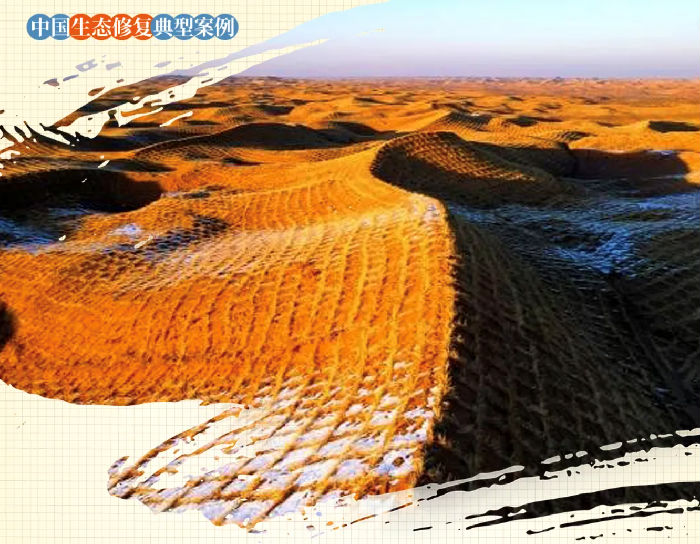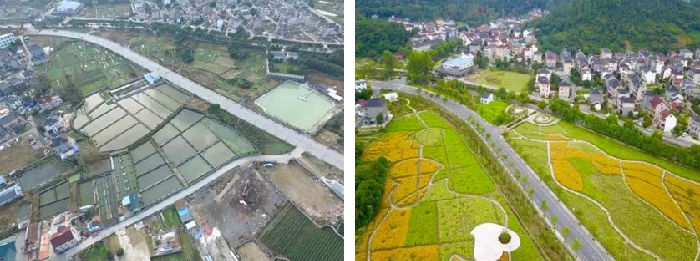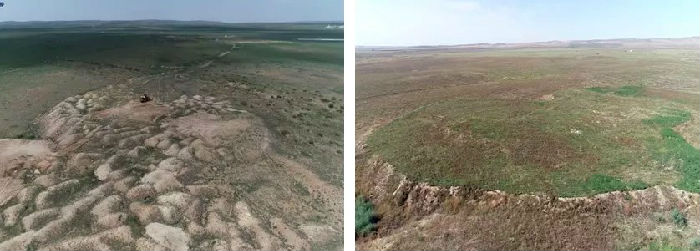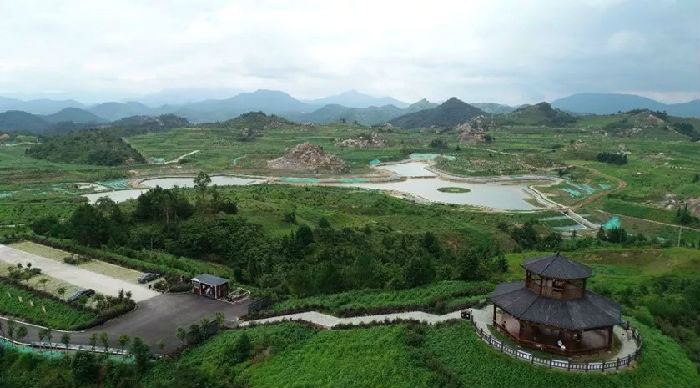



The 15th meeting of the Conference of the Parties to the United Nations Convention on Biological Diversity (COP15) kicked off in Kunming, Southwest China's Yunnan Province, on October, 11 and on the afternoon of October 14, 2021, the Ministry of Natural Resources released "Typical Cases of Ecological Restoration in China" (including 18 cases) at the Theme 4 - "On Ecological Protection and Restoration Based on Natural Solutions" of Ecological Civilization Forum of COP15. The 18 cases are selected from the 127 nominated ecological restoration projects by relevant ministries, provincial natural resources authorities and the commonweal organizations. These cases aim to show the diversity of ecosystem, typical problems on ecosystem and comprehensive methods of ecological restoration.
Case 13: Comprehensive land consolidation and ecological restoration in Shuangpu Town, Xihu District, Hangzhou, Zhejiang
Shuangpu Town in Xihu District is located at the confluence of Qiantang River, Fuchun River and Puyang River. This town was facing the typical problems of land management and utilization in the fringe area between urban and rural areas, such as fragmentation of rural arable land, disordered spatial layout of built-up land, inefficient land uses, and environmental pollution issues. Beginning in 2017, Hangzhou started to implement comprehensive rural land consolidation and ecological restoration; Shuangpu Town is one of the pilot towns. Under the guidance of territorial and spatial planning, the local governments experimented with many land consolidation methods in aspects of the built-up environment of rural human settlements improvement, farmland ecosystem creation, river channel improvement, ecological restoration of abandoned mines and modern agriculture development.

Aerial view of farmland in Shuangpu Town
Case 14: Desertification control of Babusha Forest Farm in Gulang
The Babusa Forest Farm in Gulang County, Gansu Province is a collective forest farm established in 1981 by means of joint household contracting. It is located on the southern edge of the Tengger Desert in Gulang County. After 40 years of desertification prevention and control in the forest farm, the coverage of forest and grass vegetation in the area has increased from less than 3% to more than 60% now. Following the model of "company + base + farmer households", the forest farm has established a corporate management mechanism of the forest industry. A new way of "fostering forests with agriculture, controlling sand with forests, and developing industries based on forests". On March 29, 2019, the Central Propaganda Department awarded the title of "Model of the Times" to the three generations of "six old men" for their contributions to sand control and afforestation of the Babusa Forest Farm.

The sand control method in Babusha Forest Farm
Case 15: Management of landscape, forest, field, lake and grass system in antimony coal mine area of Lengshuijiang, Loudi
The Lengshuijiang Antimony Coal Mine is located in Loudi City, Hunan Province, in the middle and lower reaches of the Xiangjiang River Basin, across Lengshuijiang City, Xinhua County, and Lianyuan City. It is known as the "Antimony Capital of the World" and the "Jiangnan Coal Sea". The mining area has been exploited for more than 120 years, and its ecological environment problems are increasingly serious. The Lengshuijiang antimony coal mine area has implemented a system of management of mountains, waters, forests, lakes, grasses and sands through actions such as remediation of mines, treatment of polluted water bodies, treatment of exposed mountains, treatment of waste fields, and treatment of geological disasters.
The number of coal mines has been reduced from 171 in 2010 to 15 now; antimony mines have been consolidated into only two, and antimony smelting enterprises have been reduced from 91 to nine. The environment management actions include concentrated landfilling and greening of the mixed slag in the field, harmless treatment of the arsenic-alkali slag, river dredging, ecological bank protection, planting more than 20,000 acres of trees, planting yellow peach, honeysuckle and other economic crops. The local government also focused on geological disasters caused by mining, repair of damaged houses and resettlement projects. All these efforts adapted to its local conditions and combined the geological relics, industrial and mining sites with red culture to develop popular science, sightseeing, research, and tourism to promote rural revitalization.

Before and after photos of coal mines greening
Case 16: Ecological Restoration of Degraded Grassland in Xilinhot
Xilinhot City in Inner Mongolia Autonomous Region is located in the north of Beijing which is the closest pasture land to the Beijing-Tianjin area. The grassland area in Xinlinhot is 13 960 km2 which was delineated as basic grassland in 2009. Since 2019, the State Forestry and Grassland Administration has implemented a pilot project for ecological restoration of degraded grasslands with artificial grass planting and Xilinhot City has been a pilot area. There are three main restoration projects implemented. The first one is the ecological management of 666.7 hectares of severely desertified grassland; the second is ecological restoration and treatment of 4333.3 hectares of degraded grassland; the third is the cultivation of 66.7 hectares of wild native grass species. After years of ecological restoration, the vegetation coverage of pastures increased to 40%-60% and hey production of pastures increased more than 50%. Also, the vegetation coverage of degraded pastures increased by 15%-20%, and its hey production increased by 20%-40% on average. The proportion of good pasture & hay species has increased, and soil organic matter has increased by more than 10%. The vegetation coverage of severely desertified grasslands has reached 40%-50%. Wind erosion has been controlled, and the surrounding environment has improved significantly.

The change of severely desertified grassland
Case 17: Comprehensive Treatment of Abandoned Mines in Xunwu County
Xunwu County of Jiangxi Province is located at the junction of the three provinces of Jiangxi, Guangdong and Fujian. It is the head of the Ganjiang, Dongjiang and Hanjiang rivers, and belongs to the key ecological function area of forest biodiversity in the Nanling Mountains. Xunwu started rare-earth production in the 1970s. However, due to the backward technology and the neglect of ecological and environmental protection, there is 14 sq. km of abandoned rare-earth mines resulting in many ecological problems, such as vegetation destruction, soil erosion, river siltation, arable land inundation, water pollution, and soil acidification. After the comprehensive treatments, the abandoned mines were changed into green mountains and promoted the development of local economy. Xunwu, has become a typical case of ecological restoration of abandoned mining areas in South China.

The change of rare-earth abandoned mines
Case 18: Ecological restoration of Guangyang Island, Chongqing
Guangyang is an island of the Yangtze River between Tongluo Mountain and Mingyue Mountain in Chongqing. It is the largest green island in the upper reaches of the Yangtze River. Before 2017, Guangyang Island used to be planned for large-scale real estate developments, which caused serious damage to the environment. In August 2017, the local government of Chongqing stopped these developments and started to develop this island as an ecological island in the Yangtze River. The overall plan takes six strategies focusing on the mountain, water, forest, land, lake and grass to protect the environment and promote ecological restoration. Now, there are 67% of island area protected and more than 500 kinds of plant species in the island. Since the island opened in August 2020, more than 60 000 citizens have visited and the beautiful environment has attracted more than 500 companies to settle in.

Photo of Guangyang Island
Photos from the Ministry of Natural Resources(Wechat official account)
Source: <https://mp.weixin.qq.com/s/6MbYcGZHvQ6_1InxgGI-Ww>
Edited and translated by Jia Mengyuan